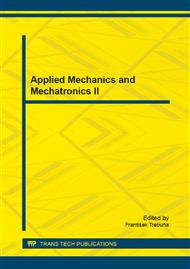[1]
F. Trebuňa, F. Šimčák, J. Bocko, P. Trebuňa, Failure analysis of mechanical elements in steelworks equipment by methods of experimental mechanics, Engineering Failure Analysis, 17(4), 2010, 787-801.
DOI: 10.1016/j.engfailanal.2009.10.011
Google Scholar
[2]
J.W. Dally, W.F. Riley, Experimental Stress Analysis, Second Edition, McGraw-Hill Book Company, New York, (1978).
Google Scholar
[3]
M. Sutton, J. -J. Orteu, H. Schreier, Image Correlation for Shape, Motion and Deformation Measurements - Basic Concepts, Theory and Applications, Springer Science+Business Media, LLC (2009).
DOI: 10.1007/978-0-387-78747-3
Google Scholar
[4]
M. Pástor, F. Trebuňa, Application of transmission photoelasticimetry for stress concentration analyses in construction supporting parts, Applied Mechanics and Materials, 611, 2014, 443-449.
DOI: 10.4028/www.scientific.net/amm.611.443
Google Scholar
[5]
A.S. Kobayashi, Handbook on Experimental Mechanics, VCM SEM, New York, (1993).
Google Scholar
[6]
F. Trebuňa, F. Šimčák, Handbook on Experimental Mechanics, first ed., Typopress, Košice, (2007).
Google Scholar
[7]
R. Huňady, P. Frankovský, M. Znamenáková, Verification of strain measurement process by digital image correlation, Acta Mechanica Slovaca, 12(3), 2008, 57-68.
Google Scholar
[8]
A. Ma et al., A new method to detect soft-tissue deformation based on HAMMER algorithm, IFMBE Proceedings, 39, 2013, 2178-2181.
Google Scholar
[9]
F. Zhu et al., Measurement of true stress-strain curves and evolution of plastic zone of low carbon steel under uniaxial tension using digital image correlation, Optics and Lasers in Engineering, 65, 2014, 81-88.
DOI: 10.1016/j.optlaseng.2014.06.013
Google Scholar
[10]
Z. Wang, H. Nguyen, J. Quisberth, Audio extraction from silent high-speed video using an optical technique, Optical Engineering, 53(11), 2014, 1-3.
DOI: 10.1117/1.oe.53.11.110502
Google Scholar
[11]
R. Wu et al., Determination of three-dimensional movement for rotary blades using digital image correlation, Optics and Lasers in Engineering, 65, 2015, 38-45.
DOI: 10.1016/j.optlaseng.2014.04.020
Google Scholar
[12]
M. Hagara, R. Huňady, Q-STRESS v. 1. 0 – a Tool for Determination of Stress Fields Using Digital Image Correlation Systems, Procedia Engineering, 96, 2014, 136-142.
DOI: 10.1016/j.proeng.2014.12.132
Google Scholar


